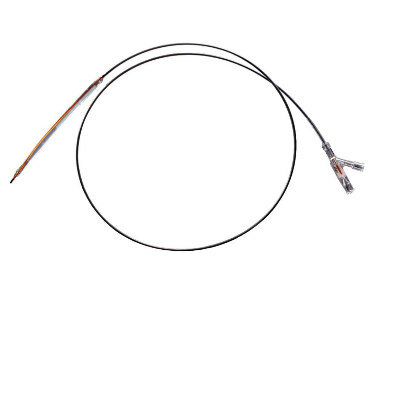FFR Guidance System Confirms Coronary Stent Necessity
|
By HospiMedica International staff writers Posted on 23 Dec 2019 |

Image: The FFRangio system dashboard (Photo courtesy of CathWorks)
A non-invasive fractional flow reserve (FFR) system delivers multi-vessel physiologic measurements to support functional evaluation of coronary artery disease (CAD).
The CathWorks (Kfar Saba, Israel) FFRangio System provides intra-procedural non-invasive diagnostic technology that aids qualitative analysis of previously acquired angiography data in CAD patients. The software based system is installed on a mobile cart that holds a computer processing unit, a user interface with an LCD screen and keyboard/mouse combo, an isolation transformer, and a network isolator. System operation requires only a mains power connections and a digital imaging and communications in medicine (DICOM) communication port to retrieve X-ray C-arm images.
The system also supports visual output to the Cath Lab main displays, so that the system user interface may be observed on both the system's LCD display and on the Cath Lab's main display (boom monitor). In order to calculate FFRangio, a value derived from simulated blood flow data obtained from coronary angiography images, the user first selects the appropriate images, and following system prompts, marks key features, including target lesion, ostium location, main vessel, target vessel, and its side branches. The system then matches the corresponding vessels among the projections to generate a 3D computer model of the vessels and determine FFRangio.
“Doctors knew that conventional FFR provided valuable objective data, but that came with the cost, risk, and time,” said Professor Ran Kornowski, MD, chairman of cardiology at Rabin Medical Center (Petah Tikva, Israel) and co-inventor of the CathWorks technology. “We believe that we have accomplished our goal of providing doctors with objective data to inform their clinical decision-making without an additional intervention.”
FFR is a physiological index used to determine the hemodynamic severity of atherosclerotic narrowing of the coronary arteries. It specifically identifies which coronary narrowing is responsible for the ischemic obstruction of the flow of blood to a patient’s heart muscle, and helps guide interventional cardiologists in determining which lesions warrant stenting, resulting in improved patient outcomes and reduced health care costs.
Related Links:
CathWorks
The CathWorks (Kfar Saba, Israel) FFRangio System provides intra-procedural non-invasive diagnostic technology that aids qualitative analysis of previously acquired angiography data in CAD patients. The software based system is installed on a mobile cart that holds a computer processing unit, a user interface with an LCD screen and keyboard/mouse combo, an isolation transformer, and a network isolator. System operation requires only a mains power connections and a digital imaging and communications in medicine (DICOM) communication port to retrieve X-ray C-arm images.
The system also supports visual output to the Cath Lab main displays, so that the system user interface may be observed on both the system's LCD display and on the Cath Lab's main display (boom monitor). In order to calculate FFRangio, a value derived from simulated blood flow data obtained from coronary angiography images, the user first selects the appropriate images, and following system prompts, marks key features, including target lesion, ostium location, main vessel, target vessel, and its side branches. The system then matches the corresponding vessels among the projections to generate a 3D computer model of the vessels and determine FFRangio.
“Doctors knew that conventional FFR provided valuable objective data, but that came with the cost, risk, and time,” said Professor Ran Kornowski, MD, chairman of cardiology at Rabin Medical Center (Petah Tikva, Israel) and co-inventor of the CathWorks technology. “We believe that we have accomplished our goal of providing doctors with objective data to inform their clinical decision-making without an additional intervention.”
FFR is a physiological index used to determine the hemodynamic severity of atherosclerotic narrowing of the coronary arteries. It specifically identifies which coronary narrowing is responsible for the ischemic obstruction of the flow of blood to a patient’s heart muscle, and helps guide interventional cardiologists in determining which lesions warrant stenting, resulting in improved patient outcomes and reduced health care costs.
Related Links:
CathWorks
Latest Critical Care News
- 'Universal' Kidney to Match Any Blood Type
- Light-Based Technology to Measure Brain Blood Flow Could Diagnose Stroke and TBI
- AI Heart Attack Risk Assessment Tool Outperforms Existing Methods
- Smartphone Imaging System Enables Early Oral Cancer Detection
- Swallowable Pill-Sized Bioprinter Treats GI Tract Injuries

- Personalized Brain “Pacemakers” Could Help Patients with Hard-To-Treat Epilepsy
- Microscopic DNA Flower Robots to Enable Precision Medicine Delivery
- Origami Robots to Deliver Medicine Less Invasively and More Effectively
- Improved Cough-Detection Technology Aids Health Monitoring
- AI Identifies Children in ER Likely to Develop Sepsis Within 48 Hours
- New Radiofrequency Therapy Slows Glioblastoma Growth
- Battery-Free Wireless Multi-Sensing Platform Revolutionizes Pressure Injury Detection
- Multimodal AI to Revolutionize Cardiovascular Disease Diagnosis and Treatment
- AI System Reveals Hidden Diagnostic Patterns in Electronic Health Records
- Highly Sensitive On-Skin Sensing Monitor Detects Vitamin B6 and Glucose in Sweat
- Artificial Intelligence Revolutionizing Pediatric Anesthesia Management
Channels
Surgical Techniques
view channel
Minimally Invasive Endoscopic Surgery Improves Severe Stroke Outcomes
Intracerebral hemorrhage, a type of stroke caused by bleeding deep within the brain, remains one of the most challenging neurological emergencies to treat. Accounting for about 15% of all strokes, it carries... Read more
Novel Glue Prevents Complications After Breast Cancer Surgery
Seroma and prolonged lymphorrhea are among the most common complications following axillary lymphadenectomy in breast cancer patients. These postoperative issues can delay recovery and postpone the start... Read morePatient Care
view channel
Revolutionary Automatic IV-Line Flushing Device to Enhance Infusion Care
More than 80% of in-hospital patients receive intravenous (IV) therapy. Every dose of IV medicine delivered in a small volume (<250 mL) infusion bag should be followed by subsequent flushing to ensure... Read more
VR Training Tool Combats Contamination of Portable Medical Equipment
Healthcare-associated infections (HAIs) impact one in every 31 patients, cause nearly 100,000 deaths each year, and cost USD 28.4 billion in direct medical expenses. Notably, up to 75% of these infections... Read more
Portable Biosensor Platform to Reduce Hospital-Acquired Infections
Approximately 4 million patients in the European Union acquire healthcare-associated infections (HAIs) or nosocomial infections each year, with around 37,000 deaths directly resulting from these infections,... Read moreFirst-Of-Its-Kind Portable Germicidal Light Technology Disinfects High-Touch Clinical Surfaces in Seconds
Reducing healthcare-acquired infections (HAIs) remains a pressing issue within global healthcare systems. In the United States alone, 1.7 million patients contract HAIs annually, leading to approximately... Read moreHealth IT
view channel
Printable Molecule-Selective Nanoparticles Enable Mass Production of Wearable Biosensors
The future of medicine is likely to focus on the personalization of healthcare—understanding exactly what an individual requires and delivering the appropriate combination of nutrients, metabolites, and... Read moreBusiness
view channel
Philips and Masimo Partner to Advance Patient Monitoring Measurement Technologies
Royal Philips (Amsterdam, Netherlands) and Masimo (Irvine, California, USA) have renewed their multi-year strategic collaboration, combining Philips’ expertise in patient monitoring with Masimo’s noninvasive... Read more
B. Braun Acquires Digital Microsurgery Company True Digital Surgery
The high-end microsurgery market in neurosurgery, spine, and ENT is undergoing a significant transformation. Traditional analog microscopes are giving way to digital exoscopes, which provide improved visualization,... Read more
CMEF 2025 to Promote Holistic and High-Quality Development of Medical and Health Industry
The 92nd China International Medical Equipment Fair (CMEF 2025) Autumn Exhibition is scheduled to be held from September 26 to 29 at the China Import and Export Fair Complex (Canton Fair Complex) in Guangzhou.... Read more














